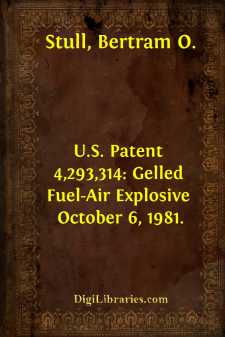Categories
- Antiques & Collectibles 13
- Architecture 36
- Art 48
- Bibles 22
- Biography & Autobiography 813
- Body, Mind & Spirit 142
- Business & Economics 28
- Children's Books 14
- Children's Fiction 11
- Computers 4
- Cooking 94
- Crafts & Hobbies 4
- Drama 346
- Education 46
- Family & Relationships 57
- Fiction 11829
- Games 19
- Gardening 17
- Health & Fitness 34
- History 1377
- House & Home 1
- Humor 147
- Juvenile Fiction 1873
- Juvenile Nonfiction 202
- Language Arts & Disciplines 88
- Law 16
- Literary Collections 686
- Literary Criticism 179
- Mathematics 13
- Medical 41
- Music 40
- Nature 179
- Non-Classifiable 1768
- Performing Arts 7
- Periodicals 1453
- Philosophy 64
- Photography 2
- Poetry 896
- Political Science 203
- Psychology 42
- Reference 154
- Religion 513
- Science 126
- Self-Help 84
- Social Science 81
- Sports & Recreation 34
- Study Aids 3
- Technology & Engineering 59
- Transportation 23
- Travel 463
- True Crime 29
U.S. Patent 4,293,314: Gelled Fuel-Air Explosive October 6, 1981.
by: Bertram O. Stull
Categories:
Description:
Excerpt
GELLED FUEL-AIR EXPLOSIVE METHOD
1. Field of the Invention 5
This invention relates to fuels for fuel air explosive weapons. More particularly, this invention relates to a method for causing an explosion comprising the steps of dispersing a cloud of liquid fuel in the air and detonating the cloud wherein the cloud is composed of particles of 10 gelled or ungelled 1,2-butylene oxide.
1. Description of the Prior Art
Fuel air explosive weapons are now well known. A typical example of one is depicted in U.S. Pat. No. 3,955,509 which was issued to Gary A. Carlson on May 15 11, 1976.
Fuel air explosive weapons may be described as devices which, upon activation, cause liquid fuel particles to be dispersed in the form of a detonable cloud in the air and then detonate the cloud. 20
A number of fuels have been used in fuel air explosive weapons. Among these are ethylene oxide and propylene oxide. Because of the ease with which is cloud of ethylene oxide or propylene oxide can be detonated, these two materials are the most commonly used. However, 25 these fuels have certain drawbacks.
One drawback, common to both ethylene oxide and propylene oxide, is toxicity. Both materials are highly toxic. A concentration of 50 parts per million of ethylene 30 oxide in the air may have harmful effects on one breathing the air for about 8 hours. Propylene oxide is less toxic than ethylene oxide but is still highly toxic. A concentration of 100 parts per million of propylene oxide breathed for about 8 hours may have undesirable 35 effects. Naturally, when fuel air explosive devices are stored in a confined area such as aboard a ship, exposure for 8 hours is not unusual.
Another drawback common to ethylene oxide and propylene oxide is the fact that both have relatively low 40 boiling points, 10.4° C. and 34.2° C. respectively. This makes the two difficult to handle in loading operations. High vapor pressures also contribute to difficulty in handling.
A drawback particularly associated with ethylene 45 oxide is its tendency to polymerize during storage. Left alone in a fuel air explosive weapon or other container, ethylene oxide tends to self polymerize. The polymerized material is unsuitable for use as a fuel for a fuel air explosive device. Unpolymerized ethylene oxide, on the 50 other hand is highly desirable as a fuel insofar as detonability is concerned. Clouds containing from as little as 3 up to as much as 100 percent by volume of ethylene oxide are detonable. The detonation limits of propylene oxide, on the other hand, range from about 3.1 to about 55 27.5 percent by volume.
It has now been found that 1,2-butylene oxide, when used as a fuel for fuel air explosive devices, exhibits marked superiority over either ethylene oxide or propylene 60 oxide. The marked superiority stems from the fact that 1,2-butylene oxide is about 3 times safer than propylene oxide when long exposure to it is required and about 3.5 times safer than ethylene oxide. Insofar as ease of detonation is concerned, 1,2-butylene oxide has about 65 the same explosive limits as propylene oxide....


